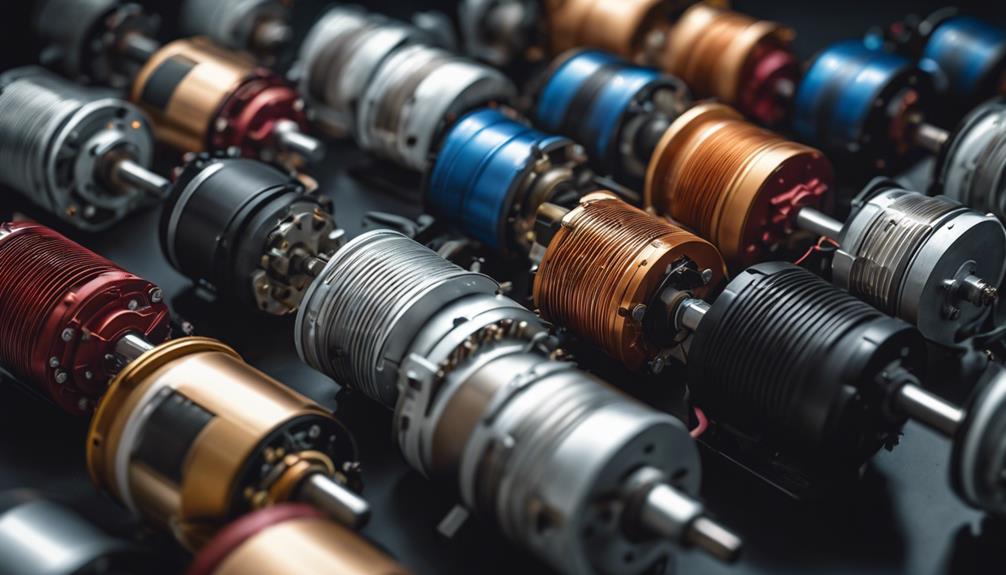Submit Your Request
Please fill out the form below.
Please fill out the form below.
Need a custom solution?

When seeking the suitable DC motor for diverse applications, the array of options may overwhelm you. Understanding the nuances between brushed and brushless motors is essential, but the intricacies go beyond just that.
Factors like torque requirements, speed control, and power efficiency play pivotal roles in your selection process. As you navigate through the varied specifications and considerations, a comprehensive guide can assist you in making an informed decision that aligns with your application’s demands.
Stay tuned to uncover the key aspects that will guide you towards the optimal DC motor choice for your specific needs.
When selecting a DC motor, it’s crucial to understand the various types available to ensure optimal performance for your specific application. Two primary distinctions in DC motors are whether they’re brushed or brushless and whether they utilize permanent magnets or wound fields.
Brushed DC motors employ brushes and a commutator to switch the current direction in the motor windings, creating the rotational motion. These motors are simpler in design but tend to require more maintenance due to brush wear over time. On the other hand, brushless DC motors use electronic controllers to energize the windings in a specific sequence, eliminating the need for brushes. This design results in less maintenance, higher efficiency, and quieter operation.
In terms of the magnet type, permanent magnet DC motors have magnets embedded in the rotor, providing a compact and efficient design. In contrast, wound field DC motors use coils in the rotor to create a magnetic field, offering more control over the motor’s characteristics. Understanding these distinctions will help you choose the most suitable DC motor for your application.
Understanding the factors that influence DC motor selection is crucial for achieving optimal performance in your specific application. When choosing a DC motor, two key factors to consider are voltage requirements and torque capabilities. Voltage requirements determine the power supply needed for the motor to operate efficiently, while torque capabilities indicate the motor’s ability to produce rotational force.
To further illustrate the importance of these factors, consider the following table:
| Factors | Description |
|---|---|
| Voltage Requirements | Defines the electrical input the motor needs for operation. |
| Torque Capabilities | Indicates the motor’s ability to generate rotational force. |
To ensure optimal performance in your specific application, it’s essential to carefully match the specifications of the DC motor to the requirements of the task at hand. One crucial aspect to consider is the torque requirements of your application. Torque is the rotational force produced by the motor to overcome resistance and drive the load. Understanding the torque needed for your application is fundamental in selecting the right DC motor.
Additionally, voltage compatibility is a key factor to address. Ensure that the voltage rating of the DC motor aligns with the power supply available in your application. Using a motor with an incompatible voltage could lead to inefficiencies, overheating, or even damage to the motor.
Before making a decision, thoroughly evaluate the torque demands of your application and confirm that the voltage specifications of the DC motor match your power source. By meticulously matching these critical specifications, you can enhance the efficiency and effectiveness of your system.
To optimize the efficiency and performance of your DC motor selection, meticulous consideration of key factors such as motor speed, current ratings, and mechanical compatibility is essential. Here are four crucial aspects to focus on for efficiency optimization and performance enhancement:
For optimal maintenance and longevity of DC motors, regular inspection and timely lubrication of components are imperative. Motor maintenance is crucial to ensure the reliability and efficiency of the system. Inspecting the motor for any signs of wear and tear, such as damaged brushes or overheating, can prevent potential breakdowns. Additionally, proper care extends the motor life significantly.
Lubricating moving parts like bearings and gears reduces friction, minimizing wear and tear on the motor components. It’s also essential to keep the motor clean from dust and debris, as these can impede its performance over time.
Routine checks on the motor’s connections and electrical components can help identify any issues before they escalate. Tightening loose connections and cleaning terminals can prevent malfunctions and ensure the motor operates smoothly. Following manufacturer guidelines for maintenance schedules and procedures is key to maximizing the lifespan of your DC motor.
When implementing a DC motor in a high-vibration environment, challenges arise due to vibration tolerance issues and motor mounting. To combat this, focus on environmental protection and utilize sealing solutions to safeguard the motor’s integrity.
To determine the optimal operating temperature range for a DC motor in your specific application, consider the motor efficiency at different temperatures. Conduct tests at varying temperatures to observe performance and find the range where efficiency is highest.
In hazardous environments, observe strict safety precautions when using DC motors. Ensure motors meet explosion-proof requirements to prevent ignition sources. Implement proper ventilation, grounding, and shielding. Regular maintenance and monitoring are crucial for safe operation.
Brushed DC motors have mechanical commutators, reducing efficiency due to friction and wear. Brushless DC motors use electronic commutation, enhancing efficiency and longevity. Brushless motors exhibit higher efficiency and longer lifespan compared to brushed ones.
Yes, a DC motor can be seamlessly integrated into a control system for precise speed and torque manipulation in industrial automation. This integration ensures optimal performance and efficiency in various automation systems for industrial applications.
In conclusion, selecting the right DC motor for your application is crucial for optimal performance and efficiency. Consider various factors such as type of motor, power requirements, speed control, and maintenance needs when making your decision.
By carefully matching motor specifications to your specific application requirements, you can ensure smooth operation and longevity of your DC motor. Remember to prioritize efficiency and performance for the best results.